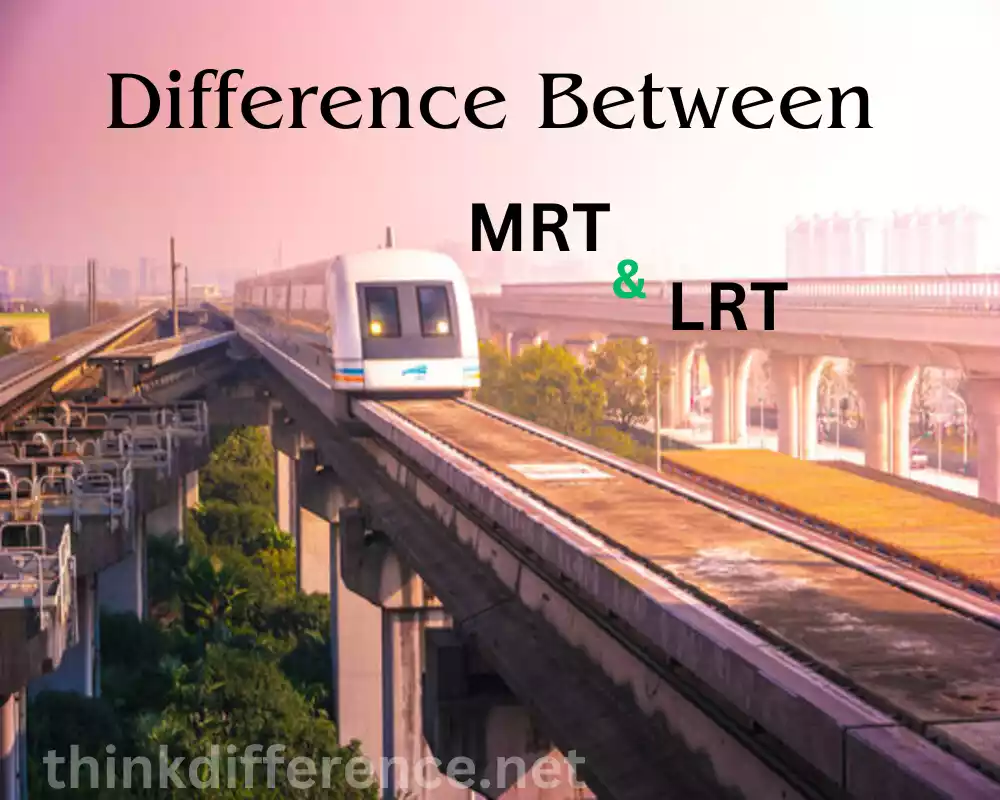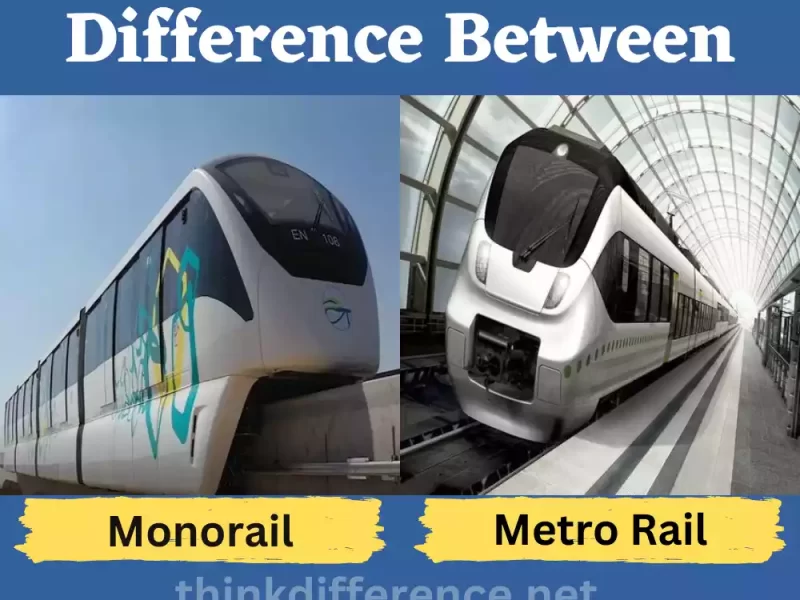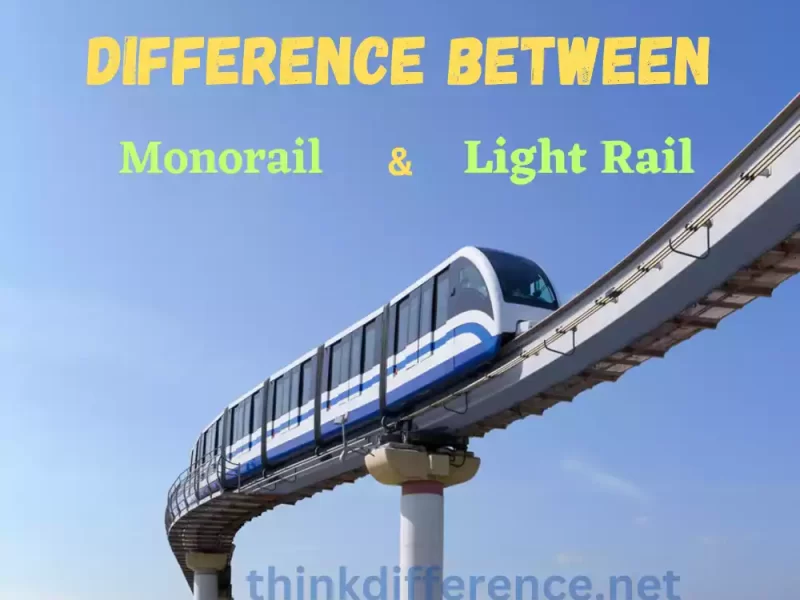MRT and LRT are two well-established forms of urban transport that have revolutionized how people navigate dense cities. Below we explore MRT/LRT’s meaning, benefits, and drawbacks before looking into how these modes compare against one another.
What is MRT?
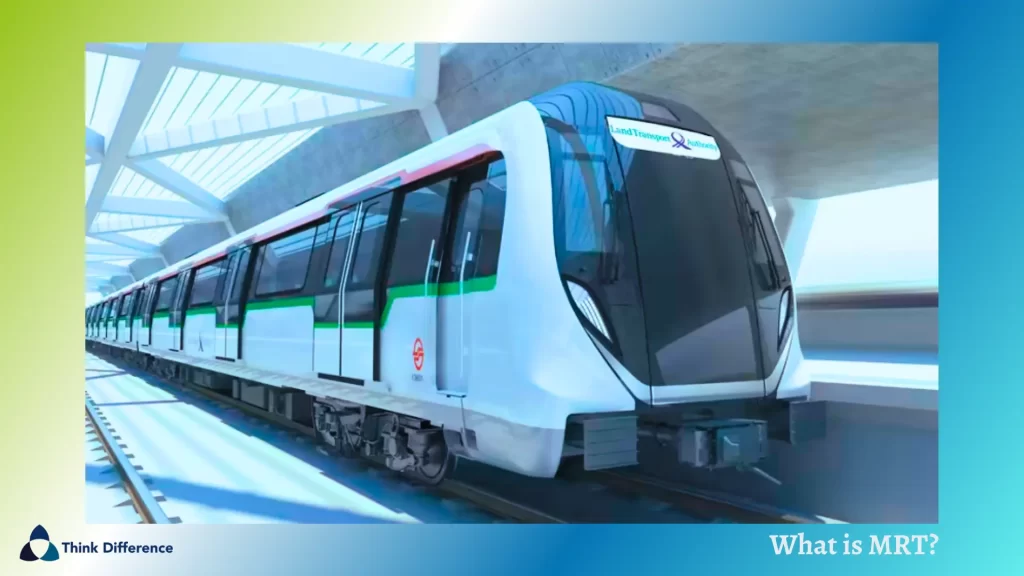
MRT stands for “Mass Rapid Transit,” and refers to citywide railway systems designed to provide quick, high-capacity transport in urban regions. MRT systems generally consist of separate tracks with larger trains that travel quickly between stations across a city – they’re known for being rapid as well as being reliable enough to carry large numbers of passengers at one time – MRT plays an essential role in combatting urban transportation problems by alleviating traffic congestion while providing access to many individuals requiring transport access; notable MRT examples are Singapore Mass Rapid Transit (SMRT) and Taipei Metro both located within Taiwan respectively.
Key features of MRT systems include:
- Dedicated Tracks: MRT trains run on dedicated tracks that are separate from roadways, ensuring uninterrupted service and minimizing traffic interference.
- Electric Trains: MRT trains are powered by electricity, typically through overhead catenary systems or third rail systems. The use of electric trains reduces environmental impact and promotes energy efficiency.
- High Passenger Capacity: MRT trains are designed to accommodate a large number of passengers. They typically have multiple cars with spacious interiors, allowing for comfortable travel even during peak hours.
- Fast and Frequent Service: MRT systems offer frequent service with short intervals between trains, ensuring minimal waiting times for passengers. The trains operate at higher speeds compared to other modes of transportation, enabling quicker travel between stations.
- Stations and Platforms: MRT stations are equipped with platforms that are at the same level as the train doors, allowing for easy boarding and alighting. Stations often have amenities such as ticketing machines, information displays and seating areas for passenger convenience.
- Integration with Other Modes of Transportation: MRT designed these systems so as to easily incorporate with other transportation options, including commuter rail, bus networks or cycling facilities, for seamless transfers and broadened accessibility for its passengers.
MRT systems have been implemented across a number of cities worldwide, such as Singapore, Tokyo, London, New York City and Dubai – serving to provide efficient transport solutions in dense urban settings. They form part of urban infrastructure by encouraging efficient yet environmentally sustainable travel solutions in areas with dense populations.
Advantages of MRT
MRT (Mass Rapid Transit) systems offer several advantages that make them a preferred mode of transportation in urban areas.
Here are the advantages of MRT:
- High capacity: MRT systems are designed to handle a large volume of passengers, making them suitable for densely populated cities. MRT trains feature larger passenger capacities to better serve peak hour commuters and reduce crowding for smoother passage.
- Speed and efficiency: MRT trains travel at much greater speeds than other forms of transport, resulting in faster journey times between stations. The dedicated tracks and signaling systems enable efficient operation and minimize delays. The frequency of MRT trains is usually high, resulting in shorter waiting times for commuters.
- Reliability: MRT systems are known for their reliability. They adhere to strict schedules and are less affected by traffic congestion compared to buses or cars. This reliability makes MRT a dependable mode of transportation, allowing commuters to plan their journeys with greater certainty.
- Reduced traffic congestion: By providing an efficient and attractive alternative to private vehicles, MRT helps reduce traffic congestion on roads. As more people choose MRT, vehicle congestion on roadways decreases significantly resulting in improved traffic flow and shorter commute times for all.
- Environmental sustainability: MRT is an environmentally friendly mode of transportation. Carbon emissions and air pollution can be reduced through using public transportation instead of private automobiles. MRT systems often use electrified trains, further minimizing the carbon footprint.
- Accessibility and convenience: MRT stations are strategically positioned throughout the city, facilitating convenient travel between residential areas, commercial centers, transport hubs and residential areas. Each MRT station features amenities to make access easier for everyone with disabilities – elevators, escalators ramps or elevators are among them.
- Integration with other transportation modes: MRT systems are often integrated with other transportation networks, such as bus interchanges and taxi stands. Integrating different modes of transport allows seamless transition, giving customers easy and effective transport choices.
- Economic development: MRT systems contribute to economic development by connecting residential areas with commercial centers, educational institutions and other important destinations. They improve accessibility to job opportunities and stimulate economic activity around the stations.
MRT systems bring many advantages, from efficient capacity speeds and reliability, less congestion to accessibility, sustainability and supporting urban economies.
Challenges and limitations of MRT
MRT (Mass Rapid Transit) systems may offer numerous benefits; however, there can also be obstacles and limitations associated with MRT services.
Here are a few key issues surrounding them.
- High cost of construction: Building MRT systems involves significant upfront investments. The construction of underground or elevated tracks, stations and other associated infrastructure can be expensive. Finance may pose a barrier, particularly in cities that lack ample financial resources.
- Long construction timelines: MRT projects often require extensive planning, engineering and construction work, which can result in long timelines. Delays in construction can disrupt schedules and impact the overall efficiency of the transportation network.
- Limited coverage and service area: MRT systems may not cover all parts of a city or region. The initial construction and expansion of MRT lines may prioritize high-density areas, leaving out suburbs or less densely populated areas. This can result in limited accessibility and inconvenience for residents in those areas.
- Inflexibility of routes: Once MRT lines are constructed, their routes are relatively fixed. This lack of flexibility makes it challenging to adapt to changing transportation needs or respond quickly to urban development patterns. It may require significant investments and planning to modify or extend existing MRT lines.
- Disruption during construction: The construction of MRT systems can cause disruptions to traffic, businesses and communities. Road closures, diversions and noise pollution during the construction phase can inconvenience residents and affect local businesses.
- Maintenance and operational costs: MRT systems require regular maintenance to ensure safety, reliability and efficiency. The cost of maintenance and operations, including staffing, electricity and infrastructure upkeep, can be substantial. Funding these ongoing costs can be a challenge, especially if there is an overreliance on fare revenues.
- Vulnerability to breakdowns and disruptions: While MRT systems are generally reliable, technical issues, equipment failures, or unforeseen incidents can cause disruptions to the service. These disruptions can inconvenience passengers, leading to delays, overcrowding and potential safety concerns.
- Limited capacity during peak hours: Despite high capacity, MRT systems can experience overcrowding during peak hours, leading to discomfort for passengers and potential safety risks. The frequency and capacity of trains may need to be carefully managed to meet the demands of a growing population.
- Integration with other transportation modes: While integration with other modes of transportation is an advantage of MRT, it can also present challenges. Coordinating schedules, ensuring smooth transfers and providing efficient interchange facilities require careful planning and coordination among different transport operators.
Important to keep in mind is that MRT systems present unique challenges. Most can be resolved with proper planning, continuous investment and regular maintenance to guarantee optimal system performance.
What is LRT?
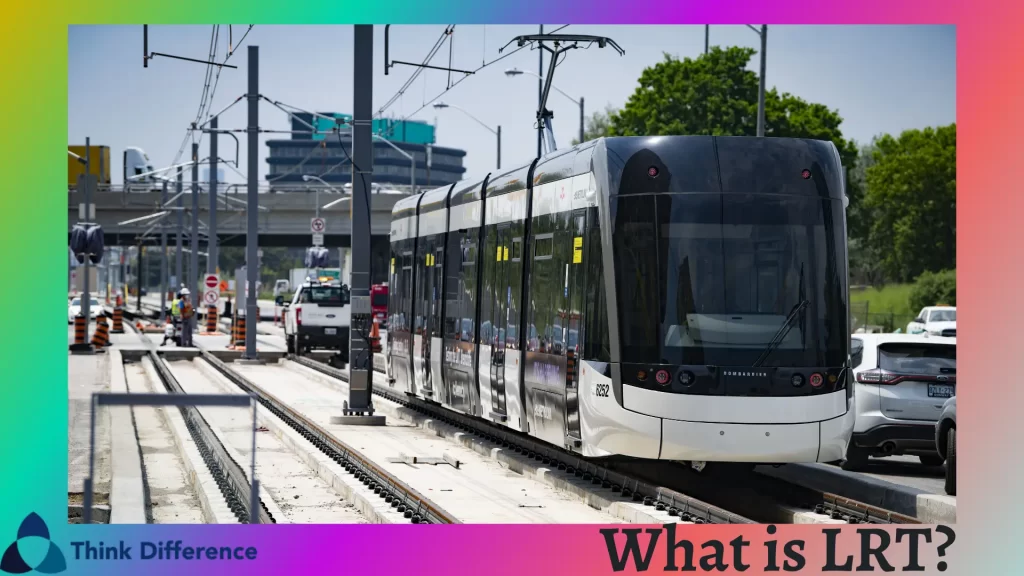
LRT stands for Light Rail Transit. It is a mode of urban rail transit that operates with lighter trains and typically serves medium-capacity transportation needs within cities and suburban areas. LRT systems are designed to provide efficient and convenient transportation options while integrating into existing urban landscapes.
Here are some key features of LRT:
- Train Size and Capacity: LRT trains are generally smaller in size compared to heavy rail systems like MRT (Mass Rapid Transit). They have a lower passenger capacity, making them suitable for medium-demand routes within urban areas.
- Infrastructure: LRT systems utilize lighter rail infrastructure. The tracks for LRT can be at-grade (street level), elevated or occasionally underground. In some sections, LRT tracks may be shared with other vehicles, such as cars and buses.
- Speed and Travel Time: LRT systems typically have lower operating speeds compared to heavy rail systems like MRT. Travel times between LRT stations may become significantly longer when traversing longer distances.
- Coverage Area: LRT systems are usually designed to serve more localized areas within a city or suburb. They connect neighborhoods, commercial centers and transportation hubs within a specific urban area.
- Flexibility and Adaptability: LRT systems offer more flexibility and adaptability to varying urban environments. They can integrate into existing urban spaces more seamlessly and can be modified or extended with relatively less disruption compared to heavy rail systems.
- Cost: LRT systems generally have lower construction and operational costs compared to heavy rail systems like MRT. The lighter rail infrastructure and smaller train sizes make LRT more cost-effective.
LRT systems are commonly found in various cities around the world, providing an accessible and convenient transportation option for shorter-distance travel within urban areas. They contribute to reducing traffic congestion, promoting sustainable mobility and enhancing connectivity within cities.
Advantages of LRT
Light Rail Transit (LRT) systems boast numerous advantages that make them the ideal mode of urban transport.
Here are a few major ones:
- Flexibility and adaptability: LRT systems are built to adapt and be flexible enough for different urban settings, operating on various tracks ranging from below-grade (street level) or elevated (above ground), underground or even both depending on each region’s requirements. This flexibility allows LRT to integrate into existing urban landscapes and accommodate different route configurations.
- Cost-effectiveness: Compared to heavy rail systems like MRT, LRT systems generally have lower construction and operational costs. The lighter rail infrastructure, smaller train sizes and ability to share tracks with other vehicles help reduce the overall cost of building and maintaining LRT systems.
- Accessibility and convenience: LRT stations are typically located within walking distance of residential areas, commercial centers and key destinations. This makes LRT easily accessible for commuters and provides convenient transportation options, reducing the need for private car usage. LRT stations often have amenities such as ticketing facilities, shelters and real-time information displays for passenger convenience.
- Capacity and frequency: Although LRT systems have smaller trains compared to MRT, they still offer sufficient capacity to accommodate medium-capacity transportation needs. LRT systems can operate at higher frequencies during peak hours, ensuring shorter waiting times for passengers.
- Integration with urban spaces: LRT systems can be integrated into urban spaces more seamlessly. By sharing tracks with other vehicles, such as cars and buses, LRT can operate within existing road networks, reducing the need for significant alterations to the urban landscape. This integration helps minimize disruption during construction and enhances the overall aesthetic appeal of the city.
- Environmental sustainability: Like MRT, LRT systems contribute to environmental sustainability by reducing traffic congestion and carbon emissions. By offering an attractive alternative to private vehicles, LRT encourages more sustainable travel choices, resulting in improved air quality and reduced greenhouse gas emissions.
- Safety and security: LRT systems typically have safety measures in place to ensure passenger security. These may include surveillance systems, emergency call boxes and staff presence at stations. The integration of LRT with other transportation modes can also enhance safety by providing well-lit and monitored pedestrian access points.
- Enhancing urban development: LRT systems can support urban development by connecting different parts of a city and stimulating economic growth along their routes. LRT stations often act as catalysts for commercial and residential development, attracting businesses, investments and housing options around them.
At all times it is vitally important to bear in mind the specific benefits and urban setting when discussing LRT benefits. Each mode of transportation offers both advantages and drawbacks; selecting which will depend upon factors like population density, infrastructure needs and economic considerations.
Challenges and limitations of LRT
While LRT (Light Rail Transit) systems offer numerous advantages, they also face certain challenges and limitations.
Here are some common challenges associated with LRT:
- Limited capacity: Compared to heavy rail systems like MRT, LRT systems generally have lower passenger capacity. The smaller train sizes and limited number of cars per train may lead to overcrowding during peak hours, which can result in discomfort for passengers.
- Speed limitations: LRT systems typically have lower operating speeds compared to MRT. This can result in longer travel times between stations, especially for longer distances. The speed limitations of LRT may make it less suitable for high-speed and long-distance transportation needs.
- Traffic interference: LRT systems often share tracks with other vehicles, such as cars and buses, in some sections. This integration can expose LRT to traffic congestion and delays caused by road conditions and other vehicles. It can also limit the ability to provide consistent and reliable service.
- Limited coverage and service area: LRT systems may have limited coverage and may not reach all parts of a city or region. The initial construction and expansion of LRT lines may prioritize high-density areas, leaving out suburbs or less densely populated areas. This can result in limited accessibility and inconvenience for residents in those areas.
- Higher susceptibility to disruptions: Compared to underground heavy rail systems, LRT systems operating at-grade or elevated tracks may be more susceptible to disruptions caused by external factors such as accidents, inclement weather or road conditions. This can impact the regularity and reliability of service.
- Higher vulnerability to delays: LRT systems that operate on tracks shared with other vehicles are more prone to delays caused by traffic congestion, accidents or maintenance issues of the shared infrastructure. These delays can affect the overall efficiency and punctuality of LRT services.
- Limited future expansion options: The flexibility and adaptability of LRT systems can also present limitations when it comes to future expansion. LRT tracks may be constrained by existing urban structures and may not have the capacity for significant expansion or route modifications without significant investments and disruptions to the surrounding areas.
- Funding and financial considerations: Building, operating and maintaining LRT systems require significant investments. Financing projects that entail large financial commitments can be problematic in areas with limited finances. The ongoing operational costs, including staffing, maintenance and energy consumption, can also be a burden on the budget.
It is essential to recognize that these issues can be effectively tackled through careful planning, effective operations and ongoing investments in LRT facilities and related services. Mitigating these limitations requires comprehensive transportation planning, integration with other modes of transportation and regular evaluations to ensure the optimal performance of LRT systems.
Differences between MRT and LRT
MRT (Mass Rapid Transit) and LRT (Light Rail Transit) are two distinct urban rail transit systems with distinctive capabilities and differences, featuring one another to offer maximum convenience to their respective communities.
Their key differences lie within these categories as follows:
- Capacity and Size:
- MRT: MRT systems generally have larger trains and higher passenger capacity. Large-capacity buses can transport many passengers at once, making them suitable for high-density areas as well as long distance travel.
- LRT: LRT systems have smaller trains and lower passenger capacity compared to MRT. They are typically designed to serve medium-capacity routes within cities and suburban areas.
- Infrastructure:
- MRT: MRT systems utilize heavy rail infrastructure, which includes dedicated tracks that are separate from road traffic. They often have underground or elevated tracks, allowing for efficient and uninterrupted service.
- LRT: LRT systems use lighter rail infrastructure, and their tracks may be at-grade (street level), elevated or occasionally underground. LRT tracks may be shared with other vehicles, such as cars and buses, in some sections.
- Speed and Travel Time:
- MRT: MRT systems are generally designed for higher speeds, enabling faster travel times between stations. They prioritize efficiency and are suitable for longer-distance travel.
- LRT: LRT systems typically have lower operating speeds compared to MRT, resulting in longer travel times between stations. They are more suitable for shorter-distance travel within urban areas.
- Coverage:
- MRT: MRT systems are often designed to cover larger areas within metropolitan regions, connecting various parts of the city and beyond. Larger scale maps tend to cover both inter-city and intra-city travel.
- LRT: LRT systems are generally designed to serve more localized areas within a city or suburb. They often connect neighborhoods, commercial centers and transportation hubs within a specific urban area.
- Flexibility and Adaptability:
- MRT: MRT systems have limited flexibility in terms of route modifications or adaptability to changing urban environments. Once the tracks are established, they are relatively fixed and require significant investments for modifications or extensions.
- LRT: LRT systems offer more flexibility and adaptability to varying urban environments. They can integrate into existing urban spaces more seamlessly and can be modified or extended with relatively less disruption.
- Cost:
- MRT: MRT systems generally involve higher construction and operational costs due to their larger scale and capacity. The heavy rail infrastructure and larger trains contribute to higher expenses.
- LRT: LRT systems tend to have lower construction and operational costs compared to MRT systems. The lighter rail infrastructure and smaller train sizes make them more cost-effective.
Be mindful that MRT and LRT systems vary across regions and cities around the globe due to being tailored according to specific local transportation needs and conditions. It is vitally important that users remember this fact.
Similarities of MRT and LRT
Though MRT (Mass Rapid Transit) and LRT (Light Rail Transit) systems differ significantly in features and operation, both forms of rail transportation provide similar solutions in urban settings. There are some similarities shared by both MRT and LRT systems.
Here are just a few that stand out:
- Rail-based Transit: Both MRT and LRT are rail-based modes of public transportation. They utilize tracks and trains to provide efficient and reliable transportation services to passengers.
- Public Transport Networks: Both MRT and LRT are integral parts of the public transportation networks in urban areas. Their primary focus is providing commuters with simple transportation solutions, eliminating their dependence on personal automobiles while alleviating congestion in traffic.
- Fixed Routes and Stations: Both MRT and LRT systems operate on fixed routes, with designated stations along the way. The routes and station locations are planned strategically to serve residential areas, commercial centers, transportation hubs, and other key destinations within the city.
- Electrified Trains: Both MRT and LRT systems commonly use electric trains powered by overhead catenary wires or third rail systems. This electrification reduces dependence on fossil fuels, contributing to environmental sustainability and reducing air pollution.
- Ticketing and Fare Systems: Both MRT and LRT systems typically employ ticketing and fare systems to facilitate fare collection from passengers. They may utilize ticket vending machines, fare gates, smart card systems or mobile apps for ticket purchases and validation.
- Passenger Amenities: Both MRT and LRT systems prioritize passenger comfort and convenience. They provide amenities such as seating, passenger information displays, audio announcements, escalators, elevators and accessible facilities for individuals with disabilities.
- Safety and Security Measures: Both MRT and LRT systems prioritize passenger safety and security. They employ measures such as surveillance cameras, emergency call buttons, trained staff and safety protocols to ensure the well-being of passengers.
- Integration with Other Modes of Transportation: These MRT or LRT systems often integrate with other modes of transportation like bus services or taxi stands. This integration allows for seamless transfers and provides passengers with multimodal transportation options.
- Urban Development Impacts: Both MRT and LRT systems can have significant impacts on urban development. They can stimulate economic growth, attract investments and influence land use patterns around their stations, leading to the development of commercial, residential and mixed-use areas.
Although MRT and LRT each possess unique qualities and operations differences, both share a common goal providing efficient, accessible, environmentally-sustainable urban transportation solutions to commuters while supporting city growth in general.
Which is Better between MRT and LRT?
Deciding between MRT (Mass Rapid Transit) or LRT (Light Rail Transit) depends on a range of variables and situations, both personal and otherwise. Both modes offer their own set of advantages and disadvantages depending on personal transportation needs as well as location specific factors, here are a few factors you should keep in mind when weighing MRT/LRT alternatives as possible alternatives for you.
- Capacity: MRT systems generally have larger trains and higher passenger capacity, making them more suitable for high-demand routes and densely populated areas. LRT systems have smaller trains and lower passenger capacity, making them better suited for medium-demand routes within urban areas.
- Speed and Travel Time: MRT systems are generally constructed for faster speeds, offering quicker journey times between stations – making them suitable for long distance travel. LRT systems generally have lower operating speeds, resulting in longer travel times for passengers, particularly for longer distances.
- Coverage Area: MRT systems are often designed to cover larger areas within metropolitan regions, connecting various parts of the city and beyond. They typically have a broader coverage area and can serve both intra-city and inter-city travel. LRT systems usually serve more localized areas within a city or suburb.
- Infrastructure and Cost: MRT systems utilize heavy rail infrastructure, which may involve higher construction and operational costs. LRT systems use lighter rail infrastructure, which generally results in lower costs. Selecting either of the two approaches depends upon both available budget and financial viability of undertakings.
- Existing Urban Landscape: LRT systems have more flexibility and adaptability to integrate into existing urban landscapes, as they can share tracks with other vehicles in some sections. MRT systems, with dedicated tracks, may require more significant alterations to the urban landscape during construction.
- Transportation Demand and Future Growth: The transportation demand and projected future growth of the area should be considered. MRT systems are better suited for high-capacity transportation needs and accommodating future growth, while LRT systems are suitable for medium-capacity needs and localized areas.
At all times it is essential to remember that selecting between MRT or LRT should not be seen as either/or. Many cities employ both modes, using MRT for corridors with higher capacity needs while LRT runs along medium capacity routes. Decisions depend on factors like population density as well as transportation needs, infrastructure considerations and long-term urban growth plans in making final selection decisions.
The better option between MRT and LRT depends on the specific context, transportation needs, capacity requirements, and other factors relevant to the area in question. Proper planning, feasibility studies and careful evaluation of these factors are crucial to making an informed decision.
Future Developments and Expansion Plans
Future developments of and expansion strategies for MRT (Mass Rapid Transit) and LRT (Light Rail Transit) systems vary among cities depending on each place’s individual urban transportation goals and needs, yet here are a few general issues and trends related to developing or expanding these systems:
- Network Expansion: Many cities with existing MRT and LRT systems have plans to expand their networks by constructing new lines or extending existing ones. These expansion plans aim to improve connectivity, reach underserved areas and accommodate future population growth.
- Intermodal Integration: Future developments often focus on enhancing intermodal connectivity by integrating MRT and LRT systems with other modes of transportation, such as bus networks, commuter rail and cycling infrastructure. Seamless transfers and multi-modal transportation options are essential for providing efficient and convenient travel experiences.
- Technology and Innovation: Future developments may involve the integration of new technologies to improve the efficiency, safety and passenger experience of MRT and LRT systems. This can include the implementation of smart infrastructure, real-time passenger information systems, contactless payment systems and energy-efficient technologies.
- Sustainability and Environmental Considerations: Future developments of MRT and LRT systems often prioritize sustainability and environmental considerations. This will require using environmentally-friendly technologies that are both more energy-efficient and eco-friendly, as well as using renewable sources of power and eco-friendly construction and operation techniques.
- Transit-Oriented Development (TOD): Many cities incorporate transit-oriented development principles into their future expansion plans. TOD involves creating mixed-use developments, including residential, commercial and recreational spaces, around MRT and LRT stations. This approach promotes walkability, reduces car dependency and maximizes land use efficiency.
- Upgrading Existing Infrastructure: Some cities focus on upgrading and modernizing their existing MRT and LRT systems to enhance capacity, reliability and passenger experience. This can involve improvements in signaling systems, station designs, train technologies and maintenance practices.
- Public-Private Partnerships (PPPs): Future expansion and developments require cooperation among government entities and private sector firms through public-private partnerships (PPP). These partnerships can provide the necessary financial resources, expertise and innovation to implement large-scale projects and ensure their successful operation.
It’s important to the specific future developments and expansion plans for MRT and LRT systems vary widely based on the unique characteristics and priorities of each city or region. These plans are typically developed through comprehensive transportation planning processes, stakeholder consultations, feasibility studies and long-term urban development strategies.
Environmental Impact of MRT and LRT
MRT (Mass Rapid Transit) and LRT (Light Rail Transit) Systems have significant positive environmental benefits when compared with other forms of transport such as private automobiles.
Here are a few advantages associated with MRT/LRT systems in terms of environmental sustainability:
- Reduced Greenhouse Gas Emissions: MRT and LRT systems are powered by electricity, which can be sourced from renewable or low-carbon energy sources. Compared to private vehicles that run on fossil fuels, MRT and LRT produce significantly lower greenhouse gas emissions per passenger-kilometer traveled, contributing to mitigating climate change.
- Air Quality Improvement: By reducing the number of private vehicles on the road, MRT and LRT systems help alleviate air pollution. The use of electric trains reduces the emissions of pollutants such as nitrogen oxides, particulate matter and volatile organic compounds, resulting in improved air quality in urban areas.
- Noise Reduction: MRT and LRT systems generate less noise compared to road-based transportation modes. The use of electric trains and the separation of tracks from road traffic contribute to reduced noise pollution in the vicinity of the rail lines, benefiting residents and improving the overall urban environment.
- Land Use Efficiency: MRT and LRT systems have higher passenger-carrying capacities compared to private vehicles. By efficiently transporting a larger number of passengers, these systems require less land for infrastructure compared to accommodating an equivalent number of people using private vehicles. This promotes compact urban development and reduces the pressure for urban sprawl.
- Reduced Traffic Congestion: MRT and LRT systems help alleviate traffic congestion by providing a convenient and efficient alternative to private vehicle use. MRT and LRT trains help drive up public transit usage, leading to improved traffic flow, shorter travel time and decreased consumption of gasoline.
- Encouragement of Sustainable Travel Behavior: MRT and LRT systems promote sustainable travel behavior by providing accessible and convenient transportation options. They encourage people to choose public transportation over private vehicles, reducing individual carbon footprints and promoting more sustainable and eco-friendly commuting habits.
- Indirect Environmental Benefits: The environmental benefits of MRT and LRT extend beyond their direct operations. These systems can stimulate urban development patterns that prioritize compact, mixed-use and transit-oriented development. Reduce dependence on car ownership while encouraging sustainable land-use practices by decreasing car dependence.
It’s important to note that the magnitude of environmental benefits depends on various factors such as the energy source for electricity, the mode share of MRT and LRT, the design of the system and the overall transportation network integration. MRT and LRT systems can contribute to lowering greenhouse gas emissions while improving air quality by minimizing noise pollution, leading to sustainable urbanization practices and supporting economic development.
Safety Measures in MRT and LRT Systems
MRT (Mass Rapid Transit) and LRT (Light Rail Transit) systems place great emphasis on passenger safety, taking several measures to safeguard both their own as well as commuter health and wellbeing.
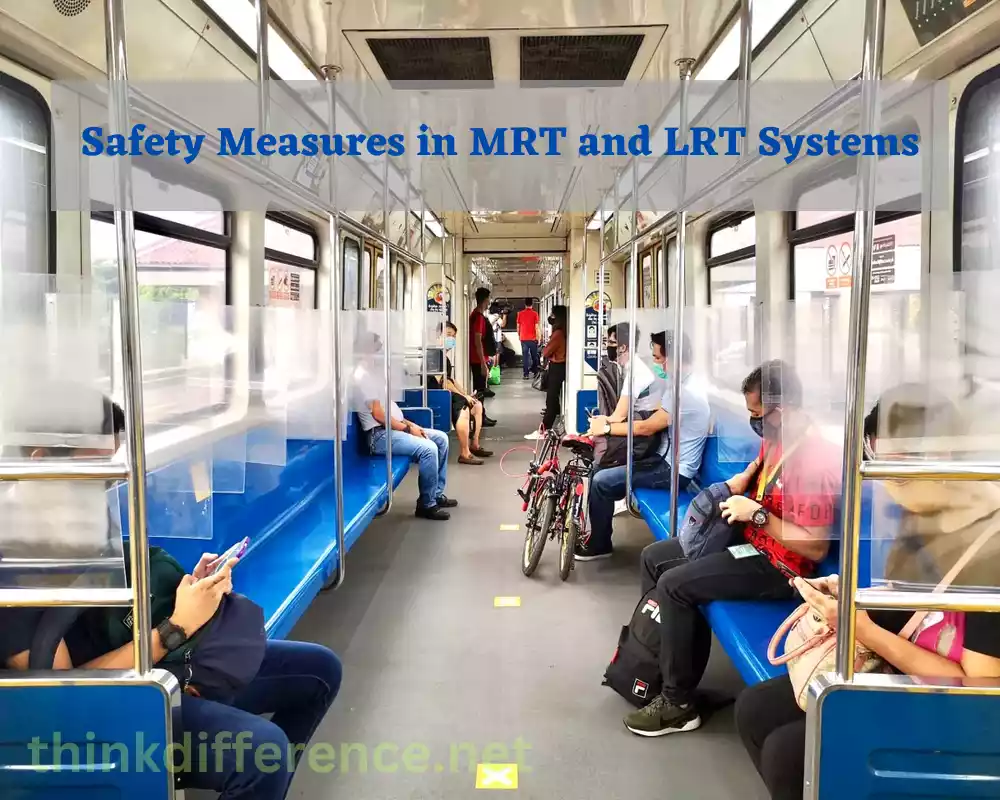
Here are some of the more commonly employed measures by both MRT and LRT systems:
- Platform Safety: Clear platform markings, barriers and designated waiting areas are installed to prevent passengers from accessing the tracks and ensure safe boarding and alighting. Platform screen doors are often utilized to create a physical barrier between the platform and the train.
- Emergency Communication Systems: MRT and LRT systems are equipped with emergency communication systems to enable passengers to quickly report any safety concerns or emergencies. Emergency call buttons, intercoms or help points are installed at stations and on trains to facilitate immediate communication with station staff or train operators.
- Passenger Information Systems: Real-time passenger information systems are employed to keep passengers informed about train schedules, station announcements and any service disruptions or emergencies. These systems include visual displays, audio announcements and digital signage to provide relevant safety information and instructions.
- Surveillance and Security: CCTV cameras are installed throughout MRT and LRT stations and trains to monitor activities and enhance security. Surveillance systems help deter criminal activities, identify potential safety risks and assist in investigating incidents.
- Staff Presence: Personnel with training – such as security personnel, station staff and train operators – are present both on board trains and at stations to guarantee passenger protection and ensure passenger safety. They provide assistance, monitor operations and respond promptly to any safety concerns or emergencies.
- Emergency Evacuation Procedures: MRT and LRT systems have well-defined emergency evacuation procedures in place. In the event of a fire, natural disaster or other emergencies, these procedures guide passengers on safe evacuation routes, assembly points and emergency exits. Regular drills and training sessions are conducted to familiarize passengers and staff with evacuation protocols.
- Fire Safety Measures: Fire safety is a critical aspect of MRT and LRT systems. As part of an overall fire prevention strategy, fire detection systems as well as suppression equipment and fireproof materials are deployed to lessen both their likelihood and their severity. Stations and trains are designed to facilitate safe evacuation in case of fire incidents.
- Accessibility Features: MRT and LRT systems prioritize accessibility for passengers with disabilities. Stations and trains are equipped with features such as ramps, elevators, tactile markings, and audio announcements to assist individuals with mobility challenges and ensure their safe and convenient travel.
- Maintenance and Inspections: Routine inspection and maintenance of railway tracks, trains, signaling systems and other infrastructures to ensure their safe operations is conducted regularly. Preventive maintenance programs and routine inspections help identify and address potential safety issues proactively.
- Safety Campaigns and Education: MRT and LRT systems engage in safety campaigns and educational initiatives to raise awareness among passengers about safety practices. These campaigns may include posters, announcements, videos and informational materials highlighting safety guidelines and proper behavior while using the systems.
Safety considerations will differ among different MRT and LRT systems based on local laws, technologies and operating practices. The safety of MRT and LRT systems is a collaborative effort involving the system operators, government authorities and passengers themselves to maintain a secure and reliable transportation environment.
Cost Considerations and Funding for MRT and LRT Projects
MRT (Mass Rapid Transit) and LRT (Light Rail Transit) projects involve considerable investments for operation, construction and maintenance costs. Typically their funding sources come from both public and private sources.
Below are some cost and financing alternatives in regard to such projects:
1. Construction Costs: The construction of MRT and LRT systems involves various expenses, including land acquisition, civil works, track laying, station construction, signaling and electrical systems, and procurement of rolling stock. The cost of construction can vary significantly depending on factors such as project scope, alignment complexity, geological conditions, and urban environment.
2. Operational Costs: Once the MRT or LRT system is operational, ongoing costs include maintenance of infrastructure, rolling stock, signaling systems, station operations, staff salaries, utilities and security. These operational expenses are incurred throughout the lifespan of the system.
3. Funding Sources:
- Government Funding: Public funding plays a crucial role in financing MRT and LRT projects. Governments at the national, regional, or local level often provide substantial financial support, either directly or through agencies or dedicated transportation funds. Governments may allocate funds from their budgets, issue bonds, or secure loans to finance these projects.
- Public-Private Partnerships (PPPs):PPPs (public-private partnerships) represent an innovative model of collaboration between private and public sectors to design, finance and construct MRT/LRT transit projects. Private companies such as construction firms, operators or investor firms offer capital knowledge experience and resources in exchange for revenue-sharing arrangements, operational rights or similar agreements. PPPs can help bridge the funding gap and share project risks.
- Multilateral Development Banks: International financial institutions such as the World Bank, Asian Development Bank and European Investment Bank offer grants, loans or technical support for infrastructure projects including MRT/LRT systems. These institutions often prioritize projects that align with sustainable development goals and promote economic growth.
- Fare Revenue: MRT and LRT systems generate revenue through fare collection from passengers. Farebox revenue can contribute to operational costs and, to some extent, help recover the initial investment. Fare revenue alone is usually insufficient to cover the entire cost of construction and operation.
4. Subsidies and Grants: Governments may provide subsidies or grants to offset the financial burden of MRT and LRT systems. These subsidies can support fare reductions for specific demographics (such as students, seniors or low-income individuals) or cover operational deficits to ensure affordable and accessible public transportation.
5. Value Capture: Value capture mechanisms aim to capture a portion of the increased property value and economic benefits resulting from the presence of MRT and LRT systems. This can be done through mechanisms such as land value taxation, development impact fees or transit-oriented development contributions. Value capture strategies help fund the construction and maintenance of transit infrastructure by leveraging the positive externalities created by the system.
6. Special Funding Mechanisms: Some cities may establish dedicated transportation funds or levies, such as sales taxes, fuel taxes or transit-oriented development fees, to generate revenue specifically for MRT and LRT projects. These funds can provide a stable and long-term source of financing.
7. International Financial Support: In certain cases, international financial support or grants from foreign governments or donor agencies can be secured to finance MRT and LRT projects, especially in developing countries where transportation infrastructure is a priority for economic development.
Cost and financing aspects in MRT as well as LRT projects vary based on factors including project location, scope, policy considerations by governments and economic circumstances. Each project requires a comprehensive financial plan with estimated costs estimates, revenue projections as well as an effective funding strategy in order to guarantee long-term success and sustainability of operations.
Conclusion
Both MRT and LRT are valuable components of urban transportation networks. MRT offers high-speed, high-capacity travel, making it ideal for long-distance and high-traffic routes. On the other hand, LRT provides flexible and cost-effective solutions for connecting neighborhoods and complementing the larger MRT network. Choosing between the two depends on the specific needs and characteristics of the city.

